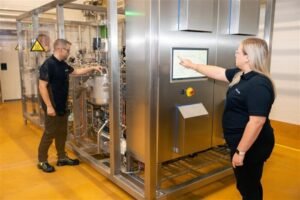Thursday, 30 October 2025
Givaudan and Berkeley publish new research providing for alternative proteins
Givaudan has launched its latest white paper entitled ‘The Protein Horizon: the landscape of alternative protein technologies enabling future food experiences. The research takes a future perspective, highlighting the benefits…

Givaudan has launched its latest white paper entitled ‘The Protein Horizon: the landscape of alternative protein technologies enabling future food experiences.
The research takes a future perspective, highlighting the benefits of emerging 3D printing technology, the ‘near future’ techniques of cultured meat, and Mycelium biomass fermentation producing fungi-derived protein. It also looks further over the horizon to lab scale technologies such as shear cell, which is set to attract significant investment. Given no single technology is the ‘silver bullet’, collaboration across companies and organizations is essential for creating delicious and nutritious meat alternatives.
Sudhir Joshi, Product Development Programme Coach at the University of California, Berkeley said: “The rise of meat alternatives is significant. The market is poised for rapid growth. While the existing technologies offer a major opportunity for innovation, the main challenges in this sector remain cost and scale.”
Givaudan is at the forefront of the meat-alternative movement but recognises that in order to create delicious new products, companies need to be agile, efficient, and innovative. Flavio continues: “Only by working together can we build the eco-systems necessary to develop the meat and fish alternative proteins of tomorrow. Our ongoing research with Berkeley is a great example of the kind of collaboration that will allow us to imagine the future of alternative proteins.”
In addition to its partnership with the Berkeley, Givaudan is also actively working with some of the latest technologies in collaboration with Bühler and Migros, with whom it has formed the Cultured Hub, in Kemptthal, Switzerland, working on cultured meat, cultured fish and seafood, and precision fermentation.
“This new white paper provides a comprehensive review of current and upcoming technologies. It also offers insights into adoption, market potential, challenges and the opportunities for future development.”
Technology
Utah State University analysis finds diestel regenerative turkeys deliver superior nutritional benefits
Oct 29, 2025 | Company News
APV introduces ‘Combi MP’ pilot to advance functional whey protein innovation
Oct 29, 2025 | Company News
FaBA partners with SeaStock to boost algae-based ingredient innovation
Oct 29, 2025 | Australia
Food Testing
Thermo Fisher Scientific launches Orbitrap mass detector for food safety testing
Oct 24, 2025 | Company News
ADM advances quality capabilities with opening of new Central Milling Laboratory
Oct 16, 2025 | Company News
South Australia now tomato virus free
Oct 13, 2025 | Australia
More Popular
Utah State University analysis finds diestel regenerative turkeys deliver superior nutritional benefits
Oct 29, 2025 | Company News
Tata Starbucks launches first estate-exclusive single-origin coffees from Coorg, Karnataka
Oct 29, 2025 | Beverages
Mondelēz posts steady Q3 growth despite record cocoa costs; projects 4%+ revenue rise in 2025
Oct 29, 2025 | Company News






